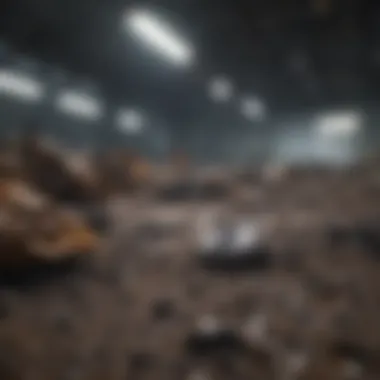Best Practices for Properly Disposing of Ballasts: A Detailed Guide


Overview of the Topic
The proper disposal of ballasts is a crucial aspect of environmental responsibility in various industries. Ballasts, commonly found in lighting systems, contain hazardous substances such as PCBs and mercury that can pose serious environmental risks if not handled correctly. Understanding how to effectively dispose of ballasts is essential to prevent pollution and ensure sustainable resource management.
Current Status and Challenges
Currently, the improper disposal of ballasts remains a significant environmental challenge. Many outdated ballasts end up in landfills, where harmful substances can leach into the soil and water systems, contributing to pollution and ecosystem damage. Moreover, the lack of awareness and enforcement of proper disposal regulations further complicates the issue, jeopardizing environmental health and safety.
Sustainable Solutions
To address the challenges associated with ballast disposal, sustainable solutions are imperative. Implementing comprehensive recycling programs for ballasts can significantly reduce environmental impact by safely extracting and disposing of hazardous materials. Additionally, promoting the use of LED technology as an alternative to traditional lighting systems can decrease the need for ballasts altogether, minimizing waste and promoting energy efficiency.
Impact and Importance
The impact of improper ballast disposal extends beyond immediate environmental concerns. Toxic substances released from improperly discarded ballasts can contaminate air, soil, and water sources, posing health risks to both humans and wildlife. By emphasizing the importance of responsible ballast disposal, we can safeguard ecosystems, protect communities from harm, and ensure a sustainable future for generations to come.
Introduction to Ballasts
In the realm of sustainable practices, the understanding of ballasts holds significant importance. Within the context of this comprehensive guide, delving into the realm of ballasts serves as a pivotal foundation for comprehending the subsequent discussions on proper disposal methods. Before venturing into the intricate details of disposal, unraveling the essence of ballasts is crucial. These devices, whether electronic or magnetic, serve a fundamental purpose in regulating the flow of current to electric-discharge lamps. By traversing through the intricacies of ballasts, individuals can grasp the underlying mechanisms that dictate their functionality, thus paving the way for informed decisions on their proper disposal. Embracing the essence of ballasts not only enriches one’s knowledge but also underscores the necessity of eco-conscious actions in safeguarding our environment.
What are Ballasts?


To illuminate the concept of ballasts, one must acknowledge their integral role in lighting systems. Acting as electrical components, ballasts find application in a myriad of lighting technologies, including fluorescent and high-intensity discharge lamps. These essential devices function by moderating the electric current passing through the lamp, ensuring stable operation and optimal performance. Beyond their technical utility, ballasts play a vital role in enhancing energy efficiency and prolonging the lifespan of lamps. By comprehending the distinctive characteristics and functions of ballasts, individuals can foster a deeper appreciation for the intricacies of lighting technologies and their ecological implications.
Types of Ballasts
Diving into the classification of ballasts reveals a spectrum of variants tailored to diverse applications. Electronic ballasts, characterized by their energy-efficient nature and reduced flickering, have gained prominence for their eco-friendly attributes. In contrast, magnetic ballasts, though less energy-efficient, remain prevalent in certain settings for their cost-effectiveness and reliable performance. Moreover, within these broad categories lie further distinctions like programmed start and instant-start ballasts, each offering unique benefits and considerations. By exploring the nuances between electronic and magnetic ballasts, individuals can make informed choices aligning with sustainability goals and environmental responsibilities.
Environmental Impact of Improper Disposal
Environmental Impact of Improper Disposal is a critical aspect that warrants thorough consideration. Improper disposal of ballasts can lead to a myriad of detrimental consequences, ranging from soil contamination to water pollution. As ballasts contain toxic components such as polychlorinated biphenyls (PCBs) and mercury, improper handling can result in these substances leaching into the environment, posing serious health risks to both human populations and wildlife.
Furthermore, the improper disposal of ballasts can significantly impact ecosystems, disrupting delicate ecological balances and potentially leading to the degradation of biodiversity. Toxic substances released from ballasts can bioaccumulate in organisms, causing long-term harm to wildlife populations. It is imperative to understand the gravity of these environmental repercussions to emphasize the importance of adopting proper disposal methods for ballasts.
In the context of this article, the Environmental Impact of Improper Disposal serves as a foundational aspect that underpins the necessity of adhering to responsible disposal practices. By shedding light on the potential hazards associated with improper disposal, readers can gain a comprehensive understanding of why environmentally conscious waste management is paramount in safeguarding our planet.
Toxic Components in Ballasts
The toxicity of components present in ballasts is a concerning issue that demands attention. These fixtures often contain hazardous materials such as PCBs, mercury, and lead, which are known for their detrimental effects on human health and the environment. PCBs, for instance, are persistent organic pollutants that can accumulate in the food chain, posing a serious threat to ecosystems.
Mercury, another common component in ballasts, is a potent neurotoxin that can cause severe health complications upon exposure. The improper disposal of ballasts containing these toxic components can result in leaching into soil and water sources, perpetuating environmental contamination and endangering living organisms.
Understanding the toxicity of components in ballasts is crucial for implementing safe disposal practices and mitigating potential harm. By recognizing the risks associated with these substances, individuals and organizations can take proactive steps to prevent environmental degradation and protect human health.
Risks to Ecosystems


The risks posed to ecosystems by improper disposal of ballasts are multifaceted and far-reaching. Ecosystems are intricate web-like systems where every organism plays a significant role. When ballasts with toxic components are irresponsibly disposed of, the delicate balance within ecosystems is disrupted.
Leakage of hazardous substances into soil and water bodies can lead to bioaccumulation in plants and animals, ultimately affecting entire food chains. This contamination can result in reduced biodiversity, disrupted reproductive cycles, and even population declines among various species.
Moreover, the risks to ecosystems extend beyond immediate environmental impacts, with long-term consequences that may endure for years. Protecting ecosystems from the risks associated with improper ballast disposal necessitates rigorous adherence to regulatory frameworks and the adoption of sustainable waste management practices.
Regulatory Frameworks
Within the realm of waste management, compliance with regulatory frameworks is essential to ensure environmental protection and public health. Regulatory bodies establish guidelines and standards for the proper handling and disposal of hazardous materials, including ballasts containing toxic components.
Regulatory frameworks outline protocols for the identification, segregation, and disposal of hazardous waste to minimize environmental impacts and prevent contamination. By adhering to these regulations, individuals and businesses can contribute to fostering a safer and cleaner environment for current and future generations.
It is imperative for stakeholders involved in waste disposal, including manufacturers, distributors, and consumers, to stay abreast of regulatory frameworks governing the handling of ballasts. By upholding these standards, we can collectively mitigate the risks associated with improper disposal and promote sustainable waste management practices.
Proper Disposal Methods
In this section of the comprehensive guide on the proper disposal of ballasts, we delve into the critical aspect of ensuring environmentally friendly and safe methods for the disposal of ballasts. Proper disposal methods play a pivotal role in mitigating the harmful impact of ballasts on the environment. By adopting appropriate disposal practices, individuals and industries can significantly contribute to environmental conservation efforts. It is imperative to highlight the significance of responsibly managing ballasts to prevent contamination of soil, water, and air. Effective disposal methods not only safeguard human health but also help in preserving the ecosystem for future generations.
Identifying Hazardous Ballasts
Identifying hazardous ballasts is a crucial step in the disposal process to prevent potential harm to the environment and human health. Hazardous ballasts often contain toxic components such as PCBs, mercury, and lead, posing serious risks if not handled properly. Recognizing the characteristics of hazardous ballasts is essential for proper disposal. These ballasts may exhibit specific markings or labels indicating their hazardous nature. It is vital to segregate these ballasts from non-hazardous ones and ensure they are managed according to regulatory guidelines to avoid environmental contamination and adverse health effects.
Recycling Options


Exploring recycling options is a sustainable approach to managing ballasts and reducing the impact on the environment. Recycling allows for the recovery of valuable materials from old ballasts, such as copper and aluminum, minimizing the need for raw resources. Various recycling facilities specialize in processing ballasts to extract reusable components while ensuring proper disposal of hazardous substances. Engaging in recycling options not only promotes resource conservation but also supports the circular economy principles, promoting environmental sustainability and reducing waste generation.
Disposal Regulations
Understanding disposal regulations is essential for compliant and responsible management of ballasts. Regulatory frameworks govern the handling, transportation, and disposal of hazardous waste, including ballasts, to prevent environmental contamination and protect public health. Complying with these regulations involves proper labeling, storage, and transportation of ballasts to authorized disposal facilities. Failure to adhere to disposal regulations can result in legal penalties and environmental fines. By staying informed and following relevant guidelines, individuals and organizations can contribute to a cleaner and safer environment for all.
Community Awareness and Education
In this section of the comprehensive guide on Proper Disposal of Ballasts, the focus shifts towards emphasizing the vital role that community awareness and education play in promoting responsible disposal practices. Community involvement is essential in spreading awareness about the environmental impact of ballast disposal. By educating the public on the potential hazards associated with improper disposal methods, communities can actively contribute to safeguarding ecosystems. Through collaborative efforts, individuals can work together to ensure the safe handling of ballasts and minimize negative repercussions on the environment.
Importance of Public Outreach
Public outreach serves as a cornerstone in fostering a culture of environmental consciousness and responsibility within communities. When engaging in public outreach initiatives, organizations can effectively disseminate information regarding proper ballast disposal methods. By reaching out to a wider audience, they can amplify the message of sustainability and encourage active participation in eco-friendly practices. Public outreach campaigns are instrumental in triggering behavioral changes and instilling a sense of accountability among individuals, thereby paving the way for a more environmentally-conscious society.
Educational Initiatives
Educational initiatives aimed at promoting proper ballast disposal practices play a pivotal role in nurturing a generation of environmentally-aware individuals. These initiatives involve educational programs in schools, community workshops, and informational campaigns designed to educate the public about the significance of eco-friendly waste management. By integrating sustainable practices into educational curricula and workshops, organizations can instill a sense of environmental stewardship in future generations. Through targeted educational initiatives, individuals are equipped with the knowledge and skills needed to make informed decisions regarding ballast disposal, thereby contributing to a sustainable future.
Conclusion
The Conclusion section of this article serves as a pivotal endpoint that encapsulates the essence of the discussion on proper disposal of ballasts. It acts as a culmination of all the insights provided in the preceding sections, underlining the critical importance of responsible disposal practices. By emphasizing the significance of adhering to eco-friendly disposal methods, the Conclusion aims to inspire readers to take actionable steps towards safeguarding the environment and promoting sustainability. Furthermore, it sheds light on the long-term benefits of adopting correct ballast disposal measures, not only for the immediate surroundings but also for broader ecological conservation efforts. The Conclusion section acts as a catalyst for change, urging individuals and industries alike to prioritize environmental responsibility in their waste management practices.
Summary of Key Points
The Summary of Key Points section condenses the complexities discussed throughout the article into concise takeaways for readers. It highlights the key elements related to ballast disposal, ranging from identifying hazardous components to exploring recycling alternatives. By summarizing the regulatory frameworks and emphasizing the risks posed by improper disposal, this section reinforces the need for informed decision-making when it comes to handling ballasts. It provides a comprehensive overview of the critical considerations involved in the disposal process, equipping readers with a holistic understanding of the subject matter.
Call to Action for Responsible Disposal
The Call to Action for Responsible Disposal section plays a crucial role in galvanizing readers towards proactive engagement with environmentally sound disposal practices. It prompts individuals to translate knowledge into action by encouraging them to participate in recycling initiatives and dispose of ballasts in compliance with regulations. By advocating for responsible waste management behaviors, this section empowers readers to become catalysts for positive change in their communities. It stresses the collective responsibility we bear towards preserving the environment and motivates individuals to play an active role in fostering sustainability through conscientious waste disposal practices.



